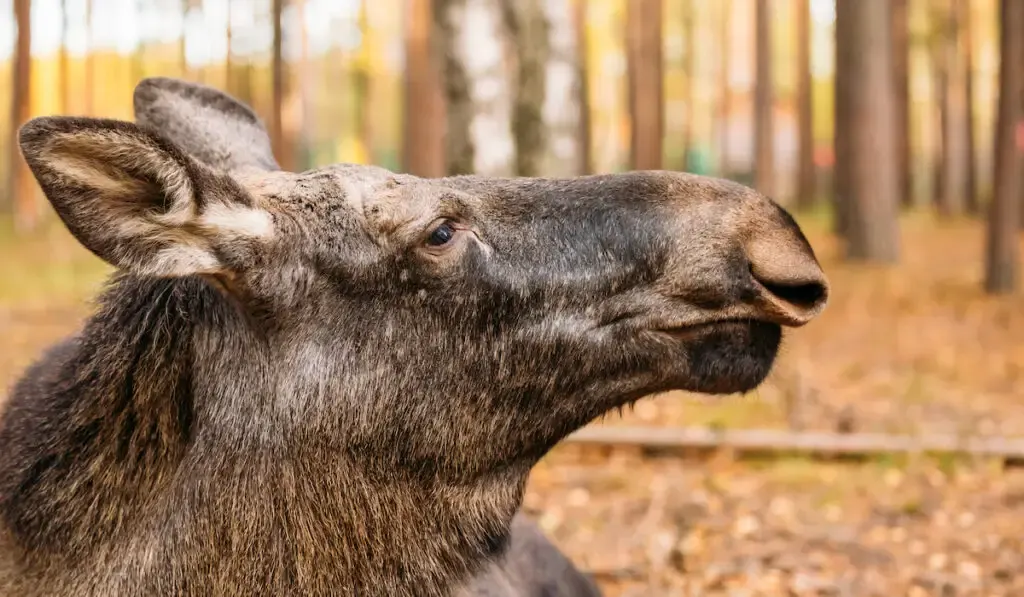Antlers are one of many features that counts toward sexual dimorphism in animals. You will find them on animals like elks, moose, caribous, white-tailed deer, and black-tailed deer. Antlers only grow in males white-tailed deer, black-tailed deer, and elks. But does this apply to moose too?
Do female moose have antlers?
Under normal circumstances, female moose do not have antlers. But in rare situations, a female moose may grow antlers. Still, if a female moose were to grow antlers, they are not for any practical use.
You may be wondering why antlers would serve no purpose on female moose. We’ll answer that and more in the rest of this article.

Table of Contents
Do Female Moose Have Antlers?
Antlers are mainly a masculine feature in moose. So, female moose would normally not have antlers. But then, in rare cases, you may find a female moose with antlers.
Antler formation and growth are hormone-driven, with testosterone and insulin-like growth factor 1 primarily controlling the growth process.
So, in the rare cases where female moose have antlers, their testosterone levels are pretty high. The elevation in testosterone in such female moose may come from a brain tumor. It may also be a result of an ovarian defect.
Unsurprisingly, female moose that have antlers typically have deformed antlers.
Female moose having antlers can be an issue where cow moose hunting is illegal. No one really expects to find a female moose with antlers. So, when hunters go hunting, they may shoot a female moose with antlers thinking it’s a male.
How to Tell a Male Moose from a Female Moose
As you may have guessed, the easiest way to tell a male moose from a female moose is the antlers. But in exceptional cases, the antlers may not be accurate. At such times, you can tell the difference between male and female moose by looking out for the following:
Chin
When you examine the chin of a moose, you will see a sagging flap of skin with long hair. This flap of skin is called the bell.
Bells are present in both male and female moose. But it is larger in male moose than female moose.
While the actual function of the bell is unknown, some moose experts suggest that it may play a role in promoting a bull for mating.
Facial Coloration
Generally, cow moose have lighter faces than bull moose. A cow moose’s muzzle is typically light-brown. Bulls, on the other hand, usually have dark-brown or black faces.
In Alaskan cow moose, the facial color is reddish-brown. But for the bulls, the muzzle is black.
Besides facial coloration, cow moose have a patch of white fur beneath their tail or around their genital area. This patch of hair is absent in bull moose.
Sex Organs
Obviously, the sex organs of moose are a way to tell the difference between cows and bulls. But then, you would have to get very close to the moose to see its sex organ.
The issue with getting too close to a moose is that they can attack without warning. And since moose are pretty fast, you may get hit before you run to safety.
Bull moose are typically aggressive during mating season. Cow moose are usually defensive when they have calves. So, you may want to avoid getting too close under such conditions.

Why Are Antlers Sometimes an Inaccurate Way to Tell the Gender of a Moose?
As previously stated in this article, female moose can sometimes have antlers. However, this is very rare. But apart from this rarity, bull moose shed their antlers in winter. So, if you try to tell the difference between a female moose and a male moose between mid-December and January, your findings may be inaccurate.
After shedding their antlers in winter, bull moose regrow them in spring and summer. So, antlers are an accurate way to tell the gender of a moose at such times.
Why Do Moose Shed Their Antlers?
As we mentioned earlier, antler development is dependent on testosterone levels. During spring and summer (when antlers grow), testosterone levels fluctuate, and antlers are soft.
But as fall approaches, testosterone levels ramp up in preparation for breeding season. This causes the antlers to harden and get a velvet covering. Then, at a point, the antlers harden completely and stop growing.
When the antlers completely harden and have their velvet covering, bull moose start rubbing them against wood. They do this throughout the mating season (September to October). Then after the mating season, they finally shed the antlers.
One of the primary reasons moose shed their antlers is to save energy for winter. Antlers can add as much as 60 pounds to the weight of moose as they harden. So, when moose lose them, they will have less body weight, and hence, do less work as they move around.

Final Thoughts
You are unlikely to find a female moose with antlers since antlers are a sexually dimorphic trait normally present in bull moose.
Still, female moose having antlers is not an impossibility. A female moose that has abnormally high levels of testosterone may have antlers.
Resources
- https://www.nationalgeographic.com/animals/article/160307-moose-drops-antler-video-wyoming
- https://www.fws.gov/nwrs/threecolumn.aspx?id=2147612672
- https://animals.mom.com/blacktailed-deer-6477.html
- https://extension.missouri.edu/publications/g9486
- https://wildlifeinformer.com/animals-with-antlers/
- https://pickhunting.com/do-female-moose-have-antlers/
- https://www.sciencedirect.com/topics/medicine-and-dentistry/antler#
- http://www.adfg.alaska.gov/index.cfm?adfg=wildlifenews.view_article&articles_id=90
- https://craigmedred.news/2018/08/27/cow-moose-bull/
- https://animals.mom.com/how-to-tell-the-difference-between-a-male-cow-calf-and-a-female-calf-4050498.html
- https://www.nationalgeographic.com/animals/article/animals-antlers-moose-seasons-mating
- https://sciencing.com/how-soon-do-male-deer-grow-antlers-13406328.html
